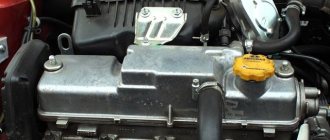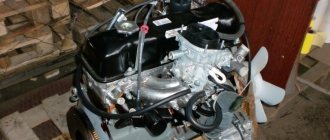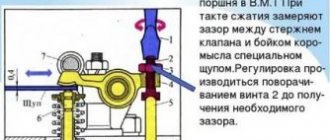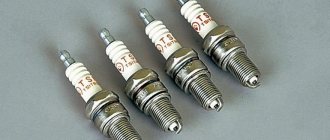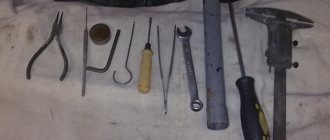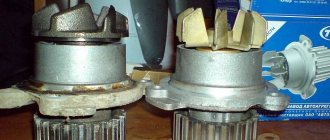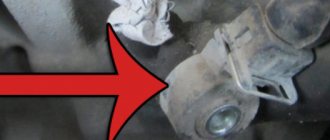Physics of the process
Let's explain what a timing belt is. The timing belt is a rubber closed belt, with notches on the inside, designed to synchronize the crankshaft and camshaft of the engine. Used when using a belt drive.
When the timing belt breaks, the camshafts stop in the position in which the break occurred, and the crankshaft continues to rotate by inertia and the pistons hit the valves with powerful force, those that were open at that moment. As a result, the valves bend (see picture). It doesn’t matter at all whether it happened in gear or not, and the number of revolutions doesn’t matter.
The crookedness of the valves is especially visible on the front two.
Do the valves on the Grant bend?
Since different versions of the Lada Granta are equipped with different engines (more about engines), the answer to the question above will be different.
On the “standard” trim levels, 8-valve 1.6-liter engines are installed, which are also used on the Lada Kalina. Such engines have already passed the test of time and have shown themselves to work well - even if the timing belt breaks, the valves remain in normal condition.
The “norm” configuration is equipped with a modernized 8-valve valve with a lightweight piston group (these are also installed on Kalina). Here the problem of pistons and valves meeting when the timing belt breaks has not been solved. This happens because special recesses are made in the pistons of such engines, and with the lightening of the ShPG, the pistons became thinner and there was no room left for the recesses.
The owners of the “luxury” will also not be able to please - their 16-valve valves also encounter a valve and piston when the belt breaks. True, there are fewer cases with such engines, but there is a risk. The main cause of breakage on such engines is jamming of the pump, tension and support rollers.
On which Grant engines do the valves bend when the timing belt breaks?
Current Grant owners claim that not all 8-valve engines are problematic. In particular, the “Standard” package is equipped with a truly high-quality power unit and will not cause serious damage to its future owner.
Breakdowns will not occur if the car is inspected and diagnosed in a timely manner. But for unit 11186 (formerly 21114), even periodic checks will not always be a preventative measure.
Features of the 11186 engine are reduced operating noise, low fuel consumption and increased power. But in addition to the advantages, the modified power unit also received some problem areas: a new connecting rod and piston system. Its main difference is the lighter weight achieved as a result of shortening the pistons. As a result, the reduced space did not allow for practical and safe placement of the mechanisms.
The risk is especially great if...
If you don’t look after the car, it will force you to take a closer look at it with large and costly repairs. At AvtoVAZ they advise changing the timing belt more often, monitoring the condition of the rollers, tensioners, etc., i.e. Carry out periodic maintenance. Although the factory gives a 120,000 km guarantee on the belt, testing this is a big risk. It is better to monitor it more often and change it in advance, before you have to spend money on a major engine overhaul.
Options for 8-valve engines are well known to Lada Granta owners from previous AvtoVAZ models. These engines have indexes 11183 and (11186, 21116), .
Domestic consumers are very afraid of a broken timing belt. Therefore, this issue plays an important role when choosing a car modification.
In the event of such a situation, bending of the valves may occur, which has given rise to the popular saying “ fist of friendship.”
".
There is even slang that refers to motors that bend valves as “plug-in”, and motors that do not have this disadvantage as “plug-in”.
Timing belt replacement period on Grant
The manufacturer of Lada cars, the AvtoVAZ concern, stipulates the timing for replacing the Granta belt - 75 thousand km. The established term applies to all Grant cars, regardless of the number of valves.
In addition to scheduled replacement, a prudent driver always monitors the condition of the drive, since it may break prematurely due to its poor quality or improper installation. Therefore, the decision “how long does it take to change the timing belt on a Grant?” Each driver decides independently.
Modification 11183 (Standard package, 82 hp)
The very first modifications of the Grant car came with a non-lightweight connecting rod and piston group; on such engines the valves do not bend, it all depends on the speed at the moment the belt breaks. These engines were installed on cars and had the designation 11183. The advantage of this engine is its high-torque power; at the bottom it drives like a diesel engine!
In fact, this is a complete copy of the VAZ-2108 engine, only with an increased volume, and the owners of the nines boasted about stories about how the timing belt broke and nothing happened to the engine.
Lada Granta 219010 timing belt
In today's test we will talk about the most important drive in a car - the gas distribution mechanism drive, or timing. We will test timing belts for the most popular car on the Russian market - Lada Granta with an 8-valve engine 21116 and its modifications (a belt with a rounded tooth, having 113 teeth and a width of 17 mm).
The tests will take place in two stages: bench and resource.
All about belt drive systems
The first is divided into several tests, but the results of the resource test will be known only by the end of summer. So, let's see.
During a search in stores, it turned out that in our region you can buy this belt from only three manufacturers: ContiTech, Gates and Trialli .
The first two belts can be purchased separately, only Trialli is sold as a repair kit with a tension pulley.
Engine 21116 (87 hp) - the valves bend!
21116 engine bends valve
This engine is installed on the Lada Granta in the “Norma” configuration. And it also bends the valves, unfortunately.
How to check the condition of the timing belt?
To visually check the timing belt, you must remove the timing cover. This is not difficult to do; with 8 valves there is a lot of space under the hood. Remove the cover and begin a visual inspection of the belt. It should be like new, without cracks or rips, without dirt or deposits, and dry.
If the condition of the belt causes concern, then it must be replaced, for more details, see the article: replacing the timing belt on an 8-valve Granta.
How to check the condition of the pump and tension pulley?
To check the condition of the pump, it is necessary to remove the lower half of the timing cover. Next, release the belt tension by loosening the tension roller. Check the functionality of the pump, spin it and see if there is any play. If there is play, then do not delay and change the pump, as it may jam in the near future.
The tension roller is checked for play in the same way.
You should also be alerted to extraneous noises when the engine is running. A sign of imminent failure of the pump and rollers is the sound of “rustling” of these elements.
There have been cases of timing belt breakage and valve bending as a result of a jammed pump and on a mileage of no more than 20,000 km.
Car engine
The first VAZ 2110 cars were produced with an 8-valve engine with a volume of 1.5 liters, and later with a 1.6 liter engine. On such units, when the timing belt breaks, the valves do not bend. This is explained by their absence in the piston. In the tenth generation, VAZ 2112 cars appeared with a 16-valve engine and a volume of 1.5 liters. With the release of this model, many car owners began to encounter problems with valve bending on the Priora. The design of the new motor has changed. Due to the 16-valve head, the power of this unit increased from 76 hp. up to 92 hp However, the big problem with such a motor is 21126 valve bending on the Priora. As a result, the car needs major repairs.
The reason why the valves in the Lada Priora were bent is the absence of special piston grooves in the 1.5 engine with 16 valves. Because of this, when the belt breaks, the pistons hit the valves, which bend them. Somewhat later, 16-valve 1.6-liter engines began to be installed on Priora. The design of these engines is practically no different from the previous ones with a volume of 1.5 liters. The main difference is that the new engine has recessed pistons. If the timing belt breaks, the pistons do not meet the valves, and the engine does not bend the valves on the Priora.
The modern engine from AvtoVAZ is presented in the form of a 16-valve unit, which differs from previous analogues in its reliability and safety; bent valves are not typical for it. However, the erroneous opinion of most car enthusiasts is due to the fact that on the updated Priora the engine bends the valves in rare cases. This is explained by the fact that this car is equipped with a 16-valve 1.6-liter engine. Practice has shown that when the timing belt breaks on a Lada, the pistons bend the valve when they meet. Repairing an engine of this type is more expensive than its “12” counterparts. The likelihood of a belt breaking on a Priora is low, since it is almost twice as wide as on “12” engines. When using a defective belt, the question “does the valve bend on a Priora?” will continue to arise.
Valves for motor
Comparing Priora and Kalina engines, auto mechanics claim that owners of a second car face a similar problem. Therefore, it is recommended to regularly monitor the condition of the timing belt. Some car enthusiasts are concerned about whether the valves bend if there is a large layer of carbon on the pistons. Similar breakdowns occur in such motors. Therefore, owners of any type of vehicle should regularly monitor the condition of the timing belt, checking it for cracks, chips, threads and peeling. These signs indicate that the timing belt needs to be changed immediately. Otherwise, the question “does the engine bend the valves on a Priora?” will not be resolved.
Lada 219010 technical characteristics engine 11186
What are the characteristics of the Lada Granta car, engine life in particular? This question is asked by many fans of the domestic automobile industry. Interest in the car is caused by its positioning as a “people's car”, characterized by budget and capacity, which allows the Grant to be classified as class C. But does the Granta’s power unit meet modern requirements?
What is engine life
Each machine has a device that determines its movement. This power unit is called an engine. In turn, each motor has a certain operating life, during which no intervention in its design is required. In mechanics, this concept has a precise name - engine life.
In other words, the resource is the mileage before the onset of repair work related to the dismantling of the crankshaft of the unit. The limiting state is determined by a drop in engine power, the appearance of uncharacteristic noise during its operation (knocking, creaking, etc.) or an increase in oil and fuel consumption.
In most cases, the condition of the engine is not related to mileage. The main factors influencing the reliability of its operation are operating conditions and workmanship. An engine operated in compliance with the rules can travel hundreds of thousands of kilometers without repair.
The engines installed on the Lada Grant belong to a new generation of power units that are successfully used by domestic models. These are engines 11183 in the standard configuration, 11186/21116 in the standard configuration, and 21116 in the luxury configuration. Each of them has its own characteristics and characteristics, which need to be considered in more detail.
Engine characteristics Grants
The VAZ 11183 engine was first used for installation on the Lada Kalina. This is a four-cylinder device with 8 valves and a volume of 1.6 liters. Structurally, this power unit is almost no different from the 21114 engine, widely used by the manufacturer on its models, starting with the VAZ-2109 and ending with modifications of the Kalina.
According to experts, both 11183 and 21114 have the same parameters and characteristics of all parts of the engine: block, camshaft, head, valves, crank mechanism, etc. That is, in fact, these are the same engine with different names .
11183 is characterized by increased environmental friendliness, reliability and increased volume. The timing drive is a belt drive, located in such a way that a broken belt does not bend the valves. This is also facilitated by deep piston recesses.
According to the plant, the service life of 21114 does not exceed 150 thousand km, but in practice the engine has successfully covered a mileage of 200 thousand. The service life of 11183 officially has an indicator of 200 thousand km.
Engine 11186 is a thoroughly modernized version of 11183 and is completely similar to engine 21116, created specifically for the Lada Granta. The differences between 11186 and 21116 lie in the manufacturer of the piston system: the first uses designs from the Federal Mogul plant, the second from AvtoVAZ. 11186 is considered the main engine of the Lada Granta liftback modification.
The modernization of the engine was carried out by engineers from the Volzhsky enterprise. They managed to achieve a reduction in the specific consumption of fuels and lubricants, while the minimum engine resource increased to 200 thousand km.
The new Lada Granta liftback car is equipped with 3 types of engines: 11186, 21126 and 21127. The VAZ 21126 with 16 valves and 2 camshafts is considered the main engine of the car. The technical characteristics of such an engine allow it to develop power up to 98 hp. and be combined with an automatic transmission. But in comparison with 21116, the 21126 engine has higher gasoline consumption and worse dynamic performance.
An even more advanced power unit 21127 allows you to achieve a power of 108 hp. At the same time, fuel consumption per 100 km range is reduced by almost 1 liter. The technical characteristics were improved by introducing into the mechanism of the intake manifold of the engine a part that performs passive supercharging.
The greatest interest among fans of AvtoVAZ models is the Lada Granta liftback, equipped with the 21127 engine, since it combines high power with the possibility of installation on an automatic transmission.
Rules for operating motors
According to car owners, the biggest disadvantage in its design is the lack of an engine temperature sensor. This indicator is necessary to monitor the quality of the engine.
Overheating is the main enemy of the cylinder-piston system. The reasons for the increase in temperature in the engine may be a lack of antifreeze, insufficient cooling, etc. If the sensor is on, all of the above situations can lead to breakdown. To prevent this from happening, experts recommend installing a digital engine temperature indicator, which will accurately reflect the state of affairs.
In order to preserve the maximum resource of the engine, it is necessary to fully comply with the manufacturer’s recommendations for maintenance of the power unit.
Thus, the recommended frequency of engine checks is 15 thousand km. In this case, you do not need to wait for the indicator on the panel to inform you about any problem: it is easier to eliminate the prerequisites for a malfunction than the malfunction itself.
When the mileage reaches 30 thousand km, you will need to replace not only the oil, but also the power system filters and spark plugs, which will also be indicated by the indicator. Often, at this mileage level, the indicator begins to inform about problems in the engine. This could be a failed timing pulley or a faulty valve cover gasket. After a mileage of 45 thousand km, the indicator will indicate the need for an oil change.
If you take a responsible approach to car operation, the resource of the power unit can be increased by thousands of km.
The 11186 engine is used in Lada Granta cars in the “Norma” and “Lux” configurations. It is a modernized version of the VAZ 11183 engine with a lightweight connecting rod and piston system, which is produced at.
Engine capacity 11186 is 1.6 cubic meters. liters This is the standard engine size for all Lada models. The power of version 1186 reaches 90 horsepower at 3800 rpm. The weight of the ShPG set in the engine has been reduced by more than a third compared to the basic version. A special feature of the new engine is the presence of an optimized cooling system for the block and cylinder head. During the manufacturing process, the cylinder head is subjected to a special heat treatment method, as a result of which it acquires new, more durable properties. The cylinder heads are equipped with durable metal gaskets.
Source: https://chevroletcars.ru/info/lada-219010-tehnicheskie-harakteristiki-dvigatel/
Main reasons
Motor device
Car owners of Lada Priora 21126 are interested in knowing the reasons why the valves on their car bend. Auto mechanics claim that on all modern models of this car, as a result of a broken timing belt, the valve motor bends. The first engines for front-wheel drive VAZ 2110, unlike similar units for rear-wheel drive, had a volume of 1.5 liters. Somewhat later, similar designs with a volume of 1.6 liters appeared. with 8 valves and one camshaft. Some car enthusiasts do not know whether the valves on such engines bend. This process does not occur due to the first elements not meeting the pistons at the dead center. After evolution, new 16-valve units with two camshafts appeared. This made it possible to increase power from 76 hp. up to 92 hp, while the engine size has not changed.
Experts say that such units are also unreliable, since when the timing belt breaks, valves and pistons meet even at a dead center, and as a result, the engine bends the second elements on the Priora. Such repairs are expensive. In addition to replacing the valve, sometimes the pistons also have to be replaced.
AvtoVAZ designers, having modified the 16-valve engine, installed it for the first time on the new VAZ 2112. The engine received the abbreviation 124. The distinctive features of the new unit from previous analogues are the presence of an updated piston group. They received “grooves” or so-called “notches”, with the help of which reliable protection is created against timing belt breakage. The VAZ 2112 with this engine is considered a reliable and powerful vehicle.
Engine malfunctions and repairs Grants 21116/11186
Before us is the 21116 engine, which is a modified 21114 1.6 liter engine. which in turn is based on the well-known 21083 engine. The differences between the 21116 engine and the VAZ 21114 are in the use of the Priorovsky lightweight (39%) SPG produced by Federal Mogul, the cylinder block is also from the Priorovsky VAZ 21126 engine. The differences between the 21116 engine and the 11186 are in the piston manufacturer, for 11186 it is manufactured by AvtoVAZ, for 21116 - Federal Mogul, that's all)) What's good about the engine: noise and gasoline consumption have decreased, environmental friendliness has increased and power has increased noticeably (almost at the level of the 124 16V), at the same time a serious drawback has appeared: if the timing belt breaks, the VAZ 21116 engine bends the valve. A lower service life is also noted compared to the old 11183 engine, despite the fact that the plant declares the service life of the VAZ 21116 engine to be 200 thousand. km. Engine VAZ 21116 1.6 l. injection in-line 4-cylinder with an overhead camshaft, the gas distribution mechanism is belt driven. The operating temperature of the Grant 11186 engine is 95 degrees. Regarding the problems, you are hearing noise and knocking from under the hood in the Lada Granta engine, or it is tripping, wasting... the article on the previous versions of this engine (2111) describes the causes of these malfunctions, read on.
Features of recessed pistons
The 10th family of cars was discontinued due to the presence of many technical flaws. The updated family has gone through major changes that affected environmental issues and increased engine power. It should be noted that all 16-valve engines are currently installed not only on Priora, but also on other VAZ models, including Kalina and Granta. However, the engine bends the valves on every such car.
The exception to the fact that if the timing belt breaks, these parts will not meet the pistons are the first eight-valve engines. Modern production of domestic cars does not provide for the use of these units. New eight-valve counterparts with increased power also bend the valves.
Since 2011, Priora had 8 valve engines marked 21114, which did not bend the valves. In recent years, the valves on all produced Lada Priora have been bent, since they have engines with 8 valves marked 21116.
Why does a belt suddenly break?
In some cases, even a new part can suddenly break, causing a lot of inconvenience to the owner of the vehicle. Most often, the teeth are worn out due to the fact that the Grant timing belt was installed incorrectly. In this case, it runs crookedly on the pulleys and rollers and its teeth “eat” the metal elements of the pulleys.
Other causes of premature wear may include:
- Poor part quality. In this case, savings can play a cruel joke on the driver, so you need to make a purchase in trusted stores
- Pump malfunction. This is one of the most common causes of breakdown. The pump rollers break over time, forming a gap and displacing the axis. As a result, its teeth quickly wear out and lead to breakage.
- Tension roller malfunction. The same thing can happen with a roller as with a butt. A bearing failure creates play and displaces the tension axis.
- Oil or antifreeze leak. When technical fluids get on the belt, they destroy the rubber from which it is made and greatly affect the strength of the part.
- Wear of pulley teeth. If the camshaft or crankshaft gears are severely damaged, integrity will be immediately affected. In this case, the teeth will have delamination on their surface.
In addition to all of the above, the fact that the timing belt on the Lada Granta 8 suddenly breaks can be caused by a trivial reason for its untimely replacement.
If the frequency of replacing the Lada Granta timing belt is not correct, then the driver should count not only on purchasing a new one, but also possibly on a complete engine repair. The cause of the rupture can be diagnosed according to the following scheme:
Cautions and Consequences
Valve bending on a Priora is mainly due to the piston meeting the first parts. If the timing belt breaks, the car owner cannot avoid expensive repairs. In such a situation, auto mechanics recommend:
- regularly check the condition of the belt,
- determine the presence of chips and cracks on the belt,
- check if there are any threads on the belt.
- remove the engine from the car,
- take it apart
- drain and replace oil,
- remove the crankshaft,
- remove the pistons
- remove the connecting rods.
Piston system
In this case, you will also need to buy a new, lighter piston group. From an official dealer it will cost no more than 2-5 dollars. Some auto mechanics recommend buying a car of another brand, the price of which is practically no different from the cost of the Priora. It could be a KIA RIO or a Chevrolet Aveo. This problem can be solved using an optimized cooling system for the block and cylinder head.
Frequent timing belt breakage is associated with the use of low-quality automotive parts, including the idler pulley. To prevent such a breakdown, Priora car owners install the lower gear on the crankshaft, belt and rollers from the VAZ-2112 on their cars. In this case, the pump and gears on the camshaft do not change. Washers 5 mm thick are placed under the rollers. The presence of a large number of manufacturers of these parts allows you to choose high-quality and reliable products for cars.
The question is interesting and worries many - do the valves on a Lada Granta car bend when the timing belt breaks...
Replacing the belt on an 8-valve Lada Granta engine. Detailed description
After making sure that the part is in poor condition, you need to prepare for the procedure of replacing the timing belt on a Lada Granta 8 valve. First of all, you need to provide a comfortable place to work, well lit, spacious enough and safe.
Tools you will need:
- Wrenches included in the set
- Heads with extension
- Mount
- Special device for adjusting the roller
The tensioner pulley is often replaced at the same time, so it is necessary to purchase it in advance. In all stores you can buy a timing belt pulley for Granta as a set.
Before starting work, you must unscrew the ground wire from the battery.
Let's consider the process of replacing the timing belt on a Lada Granta car using the example of an 8-valve engine. Main stages of work:
Preparing for repairs. The car is jacked up and the front wheel is removed from the right side, as well as the protection that blocks access to the engine.
Removing the protective cover. On Grant cars, the plastic cover consists of two parts. It's easy to remove. First you need to unscrew the 4 bolts of the upper part, and then the lower part.
To do this, you need to use a 5-point hex key. In addition to the cover, you also need to remove the crankshaft position sensor by simply disconnecting it from the connector and removing it from the socket.
Alignment of marks. Before replacing the timing belt on Granta 16 and 8 valves, it is necessary to correctly set the engine valve timing. To do this, you need to turn the crankshaft clockwise. This is done using a 17-inch socket. You need to turn it until the mark on the camshaft toothed pulley coincides with the mark on the inner surface of the timing cover.
In addition, the marks must line up on the engine flywheel. This can be checked through a special hatch in the upper part of the clutch housing. After removing the rubber plug, you need to make sure that the special protrusion on the flywheel coincides with the camshaft mark.
Only after this can you continue replacing the timing belt on the Lada Granta.
Removing the generator pulley. To prevent the shafts aligned to the marks from turning, the flywheel can be locked through the inspection hatch. The most convenient way to do this is with a thick screwdriver or pry bar. Having firmly secured the flywheel, carefully unscrew the nut holding the generator pulley and remove it along with the washer.
Next, loosen the generator pulley nut
Adjusting the tension roller. Using a 15mm wrench, you need to gradually loosen the tightening of the roller mounting bolt. When the fastening is loosened enough to allow sagging, you can begin dismantling, making sure once again that all the marks match.
Withdrawal. The part is carefully removed from all pulleys and removed from the engine compartment. If there is a complete break in the timing belt on Grant's car, this is even easier to do.
Helpful advice: while you are changing the timing belt on the Grant, the protective cover is removed and you can check the condition of the water pump and tensioner pulley. The video is removed and played in the hands. If there is no extraneous noise and the bearing does not jam, it is installed back. The water pump is checked by twisting it by the pulley. If nothing sticks, she's fine.
Installation of a new spare part.
Before use, the timing belt on Grant 8 valves is checked for manufacturing defects - peeling, cracks, excessive roughness of the material. It would be useful to look at the expiration date, since rubber loses its properties even without being used, but after lying on the shelf for several years. The number of teeth on the Lada Granta belt with an 8-valve engine is 113, and its width is 17 mm. Installation of the part is carried out in the reverse order. First, it is pulled onto the crankshaft, then onto the generator and pump, circling the roller, and at the very end - onto the camshaft. Tension. To ensure good tension, you need to rotate the roller counterclockwise. This is done using a special key, which consists of 2 metal rods. These are inserted into the corresponding holes on the roller and the roller is rotated until the cutout on the roller cage aligns with the rectangular mark on the inner sleeve. Only after this can the roller bolt be tightened.
In order to understand the sequence of work, we present to your attention an explanatory video about where to look for tags:
Physics of the process
Let's explain what a timing belt is. The timing belt is a rubber closed belt, with notches on the inside, designed to synchronize the crankshaft and camshaft of the engine. Used when using a belt drive.
When the timing belt breaks, the camshafts stop in the position in which the break occurred, and the crankshaft continues to rotate by inertia and the pistons hit the valves with powerful force, those that were open at that moment. As a result, the valves bend (see picture). It doesn’t matter at all whether it happened in gear or not, and the number of revolutions doesn’t matter.
The crookedness of the valves is especially visible on the front two.
Do the valves on the Grant bend?
Since different versions of the Lada Granta are equipped with different engines (more about the engines), the answer to the question above will be different.
On the “standard” trim levels, 8-valve 1.6-liter engines are installed, which are also used on the Lada Kalina. Such engines have already passed the test of time and have shown themselves to work well - even if the timing belt breaks, the valves remain in normal condition.
The “norm” configuration is equipped with a modernized 8-valve valve with a lightweight piston group (these are also installed on Kalina). Here the problem of pistons and valves meeting when the timing belt breaks has not been solved. This happens because special recesses are made in the pistons of such engines, and with the lightening of the ShPG, the pistons became thinner and there was no room left for the recesses.
The owners of the “luxury” will also not be able to please - their 16-valve valves also encounter a valve and piston when the belt breaks. True, there are fewer cases with such engines, but there is a risk. The main cause of breakage on such engines is jamming of the pump, tension and support rollers.
On which VAZ engines does the valve bend? table
Few car enthusiasts know which VAZ engines do not bend the valves.
AvtoVAZ has produced many models and modifications, some of which bend valves when the timing belt breaks. Often, a car with an engine where the pistons do not “meet” the valves when the belt breaks is a priority purchase, therefore, you need to know which engine models do not bend the valves. Those who are planning to buy a Lada need to know which VAZ engines do not bend the valves; this information will also be useful for the general development of car enthusiasts. It’s worth saying right away that engines that bend valves are not considered bad, and for most owners, with timely maintenance of the timing belt assembly, they do not cause problems. As mentioned above, some engines bend valves, some do not. On the same VAZ model, both the first and second types of engines could be installed, it depends on the year of manufacture. In order to have a good understanding of this topic, it is easier to remember engines that bend valves, because there are significantly fewer of them.
The following engines do not bend the valves:
- 21083
. 8 valves. Found on VAZ 2108-09-99 models. Volume 1.5 liters; - 2111
. 8 valves. Found on VAZ 2113-14-15, VAZ 2110-11-12 and Kalina models. Volume 1.5 liters; - 11183
. 8 valves. Found on the Lada Kalina model and its modifications. Volume 1.6 liters; - 21114
. 8 valves. Found on VAZ 2113-14-15, VAZ 2110-11-12 and Kalina models. Volume 1.6 liters; - 21124
. 16 valves. Found on VAZ 2110-11-12 models. Volume 1.6 liters; - 21128
. 16 valves. Found on VAZ 2110-11-12 models in the “Super-Auto” configuration. Volume 1.8 liters; - 21126
. 16 valves. Found on Lada Priora models. Doesn't bend valves only since 2013. Volume 1.6 liters.
Bends valves on the following engines:
- All classic engines. Such engines were installed on the VAZ 2101-2107 and Niva models;
- 21081
. 8 valves. Found on VAZ 2108-09-99 models. Volume 1.1 liters; - 2108
. 8 valves. Found on VAZ 2108-09-99 models. Volume 1.3 liters; - 11194
. 16 valves. Found on the Lada Kalina model and its modifications. Volume 1.4 liters; - 2112
. 16 valves. Found on VAZ 2110-11-12 models. Volume 1.5 liters; - 21116
. 8 valves. Found on the Lada Granta and Lada Kalina 2 models. Volume 1.6 liters; - 21126
. 16 valves. Found on Lada Priora models. Valve bending before 2013 release. Volume 1.6 liters.
If you are the owner of a Lada, on which the valves bend when the timing belt/chain breaks, then there are several ways to prevent the valves from bending. The simplest and smartest solution is to install plug-in pistons. Stickless pistons differ from conventional ones in that they have recesses for the valves. In the event of a belt break, the valves fit into these recesses.
The second way is to grind grooves on the original pistons. That is, make plug-free pistons from original pistons. Quite a complicated procedure. To do this, you need to find a good turner to make the recesses on the pistons deeper. Another problem is that it is difficult to make the recesses on all pistons the same. As a result, the compression ratio will not only decrease, but will also be different in all cylinders. In such a situation, it will be difficult to achieve normal operation and efficiency of the engine.
The third option is to install two or three cylinder head gaskets. The method works, but is extremely stupid. In this case, the compression ratio will drop significantly, as will the power. It is also not a fact that these cylinder head gaskets will last as long as they should.
As for classic engines, where a target is used as a drive for the gas distribution mechanism, then, as a rule, no one bothers with any alterations or modifications to this unit. It is more likely that all components and assemblies of the engine will exhaust their service life than the chain will break. The main thing is to only install high-quality parts during repairs.
It's no secret that people really love tuning VAZs. One of the main types of tuning is cylinder head tuning. This tuning also includes the installation of sports camshafts, with greater phase and lift. Many tuned camshafts make the valves open more to allow more of the air/fuel mixture to enter the combustion chamber. Such camshafts contribute to bending of the valves when the belt breaks.
So, when tuning, you need to choose a sports camshaft very carefully. It would be better not to install a camshaft at all, which bends the valve. With such a shaft, any engine will be removed from the list of those on which VAZ engines do not bend the valves. If such a shaft is installed on a car, then you need to very carefully monitor the timing belt and rollers. Install only high-quality parts and carry out maintenance in a timely manner.
There were no problems with valves bending when the piston and valve met on VAZ engines - the timing chain did its job perfectly. But the emergence of front-wheel drive models required new engines, since the Zhiguli engine had a chain in the block and its dimensions were not suitable for transverse installation. With the help of Porsche specialists, a 1.1 liter engine was developed. with a timing belt and an aluminum block mounted transversely. It all started with him.
With the use of a timing belt, there was a risk of it breaking, which means that a “ stick ” could occur. But on the first engines corresponding to Euro 2, there was no such problem - the belt sometimes broke, but without consequences. The distance between the valves and the piston was sufficient, and when desynchronized, the piston did not reach the valve.
With the advent of Euro 3 standards, a broken belt began to lead to a “meeting” of valves and piston: the engine, “strangled” by eco-standards, needed to compensate for the loss of power. This can be achieved by increasing the compression ratio. The piston at its top dead center (TDC) has become closer to the valves. It turns out that as a result of the race for better ecology and power, almost all cases of belt breakage began to lead to bending of the valves.
This happens as follows: the timing belt breaks - the camshaft stops, but not immediately, and the crankshaft rotates as before. The piston goes up and meets the stuck valve at TDC. Impact - the valve bends in a weak spot, under the “plate”. The car cannot move any further.
At best, 1-2 valves suffer, but at worst, all of them. Repair involves dismantling the cylinder head and replacing damaged valves. The pleasure is not cheap, and most importantly - unpleasant, because who likes to open a generally serviceable engine?
The risk is especially great if...
If you don’t look after the car, it will force you to take a closer look at it with large and costly repairs. At AvtoVAZ they advise changing the timing belt more often, monitoring the condition of the rollers, tensioners, etc., i.e. Carry out periodic maintenance. Although the factory gives a 120,000 km guarantee on the belt, testing this is a big risk. It is better to monitor it more often and change it in advance, before you have to spend money on a major engine overhaul.
In the fall of 2015, the Lad family of passenger cars was replenished with a top model - the Vesta car, produced in a sedan body. When asking the question “do the valves bend on the Lada Vesta,” you need to clearly imagine what kind of engine we are talking about: a 1.6-liter Russian or Nissan, or maybe the latest VAZ development with the name “21179”.
Here we consider options related to cars currently being produced or those that will begin to be produced in the near future. An 8-valve engine was also developed for Vesta - it definitely does not bend the valves and will definitely not be installed on top-end sedans in 2016.
Read more about the engines equipped with the Lada Vesta line in the material: !
ICE VAZ-21129, 106 “hp” (valve bending)
Under the hood of the 106-horsepower Lada Vesta
A little history. Motor 21129 is a modified version of another engine, namely 21127. The last of them, when the timing belt broke, successfully bent its valves, although grooves were made on the pistons (Fig. 1). The point is that the depth of the grooves was not sufficient: if certain conditions were met, the valve “met” the piston with all the ensuing consequences.
With the transition to a new generation of internal combustion engines, that is, 21129, the design of the pistons was modified. But the external shape has not changed much, and although the recesses remain, their depth is still insufficient.
Here we considered the question of whether the Lada Vesta valves with the “21129” engine are bent. And the answer was clear: yes, oppression.
In theory, the problem with valve bending is typical for all VAZ engines equipped with 4 valves per cylinder. Each new 16-valve engine “inherits” it. The exception is one rarity - the VAZ-2112 internal combustion engine, the volume of which is 1.6 liters.
There, the recesses are made conscientiously (Fig. 2).
122-horsepower engine “21179” (valve bending)
In terms of its design, the internal combustion engine of the VAZ-21179 is not very different from its predecessors. The working volume was increased to 1774 ml, which was achieved by changing the piston stroke length: it was 75.6 mm, it became 84.0 mm.
Elements of the connecting rod and piston group
The piston itself is now better fitted to the cylinder than in engines 21127 and 21129. The distance from the piston pin to the piston bottom has increased by 1.3 mm - to 26.7 mm.
But deeper grooves in the bottom never appeared. The timing mechanism still drives the belt, and if it breaks, the possibility of bending the valves has not been canceled.
Now we know whether the valves bend on a Lada Vesta with a 1.8-liter engine. The answer will be the same as for all 16-valve VAZ internal combustion engines (with the exception of 2112). The problem with the transition to a new generation remains the same. But VAZ does not intend to return to “heavy” pistons.
The timing drive on 21179 engines is equipped with not one, but two tension rollers. What was done to make the design less susceptible to timing belt stretching.
It says here: the number of tension rollers is two
One of the automatic tensioners may jam, but then its function will be taken over by the second automatic roller.
Pistons that do not bend valves
Piston kits for some “old” 16-valve engines are produced by third-party companies. These parts are equipped with deep recesses. The point is that the piston does not reach the plates and cannot bend the valves.
Tuning piston for internal combustion engines 21126-21127
ShPG elements of different engines (21127, 21129, 21179) are compatible. But there is no need to install pistons from “old engines” into the Vesta engine:
- In ICE 21129, after such “tuning”, friction losses will increase;
- If pistons from the 26th or 27th engine are installed in the ICE 21179, the working volume will immediately change.
The “29th”, as well as the “79th” Lada Vesta engine bends valves only with “VAZ” pistons. But after installing a “tuning” part, do not expect an increase in power. Also, by using non-standard elements, you can greatly reduce the resource (lose the warranty, get unforeseen consequences).
Nissan HR16DE engine (does not bend, there is a chain)
This engine is planned for installation on bodies: , and coupe! Its name is HR16DE, and its displacement is 1.6 liters. Let's look at what the piston crown looks like.
HR16DE engine disassembled
There are no “deep recesses” provided here. Now let's pay attention to how the timing drive mechanism works.
Nothing but gears and chains
There is no toothed belt here - it is replaced by a chain. It is difficult to imagine the following two situations:
- The chain could have jumped over the teeth of one or more gears;
- One of the elements was damaged so badly that the presence of damage led to rupture.
As long as the chain remains intact, the valves and pistons cannot meet each other, no matter what happens to the engine. The only bad thing is that the chain may jam.
Do the valves of a Lada Vesta with a Nissan internal combustion engine bend? The answer “no” would be wrong - a circuit break is not excluded. But in reality it will be almost impossible to face such a situation. Let's look at why.
Four Well-Known Facts
The service life of the timing chain always exceeds the service life of the engine. This is the first fact, but a condition must be met: the oil change must be timely. In general, the circuit fails gradually, and this is accompanied by symptoms:
- Audible sounds (chirping) at idle speed;
- When the “problem area” passes, a phase shift may be observed.
The last defect is detected using computer diagnostics.
From the appearance of any symptom to the complete rupture of the chain, a certain time passes. And in general, a “defective circuit” can work for a long time. This was another, fourth fact.
Before or after the purchase, sooner or later the owners of the new AvtoVAZ product will begin to worry about the question: “Do the valves on the Lada Granta bend when the belt breaks?” And car enthusiasts are puzzled by this problem with good reason, because previous models often suffered from this extremely unpleasant defect. When the timing belt broke, the valves bent, especially on the 16-valve Dvenashki and Prior engines.
As you know, the Lada Granta is based on the Lada Kalina, together with its reliable engines and non-bending valves. But, unfortunately, only owners of the Lada Granta in the “Standard” configuration can breathe easy. But the Lada Granta “Norma” is equipped with an eight-valve engine with a lightweight connecting rod-piston mechanism, and in such an engine, if the timing belt breaks, the valve will certainly face a disastrous meeting with the pistons. After such collisions, repairs, of course, cannot be avoided. It seems strange - engines with almost identical characteristics have different designs. But everything is explained by the fact that on standard 8-valve engines the pistons have recesses for the valves and they do not occur when the belt breaks. But the same engines, but with a lightweight connecting rod and piston group, are equipped with shortened pistons, in which there is simply no room left for recesses. Therefore, a rupture of the timing belt will certainly lead to bending of the valves.
Lada Priora engines have the same problem, although their belt is wide enough and the likelihood of a break is minimized. Extensive experience in operating this vehicle has shown that a timing belt break occurs extremely rarely, and only when starting to move in tow or from a pusher, which in principle is strictly forbidden to do, because when starting the engine in this case the load on the camshaft is too high and the belt jumps several incisors, which leads to sad results.
Be that as it may, the car owner is obliged to monitor the condition of the timing belt even if the pistons have recesses for the valves. Prevention has never harmed anyone, but dealing with the repair of this whole thing somewhere on the highway is not a pleasant task.
In the engine design department of the Volzhsky Automobile Plant, we found out why the new unit is better than its predecessor and what modifications were required for this.
The modernization of the eight-valve VAZ-21114 engine was brought closer by two major events: the release of Grants to the market and the transition of the entire model range to the next environmental level - Euro-4. And although the old 1.6-liter, despite its advanced age (its roots stretch back to the mid-80s of the last century), did not look like a frail old man, new standards and trends required extensive changes. At the same time, the possibilities for maneuver for motorists, as often happens, were narrowed by financial limits.
Therefore, we went along the already beaten path. After all, several years earlier, a 16-valve engine of the same volume (VAZ-21126) underwent an update, on which some technical solutions were tested. Moreover, they were able to unify not only the approach, but also many details, for example, a connecting rod with liners, a piston pin and rings. The cylinder block, although with its own index, is exactly like that of the VAZ-21126 engine: with additional nozzles for cooling the pistons with oil and plate-honing of the cylinder walls, which reduces the break-in time.
However, it was not possible to copy all the changes exactly: organizing the workflow in an engine with two valves per cylinder is more difficult. Moreover, the requirements for the modernized eight-valve engine turned out to be stricter. Take, for example, the resource - 160 thousand km for the VAZ-21126 and 200 thousand km for the VAZ-21116. Photos with captions will tell you what was changed and why.
The new H-intake module was tested on an intermediate version - the VAZ-11183-50 engine (with a Euro-4 catalytic converter, but with a heavy connecting rod and piston group). Even without relief, only by optimizing the intake and exhaust it was possible to improve the main characteristics.
The modernized unit received longer channels, which made it possible to increase the torque, approaching the performance of a sixteen-valve valve. At the same time, in the VAZ-21116 its peak was reached 700–800 rpm lower. Another important feature: an electromechanical throttle module (commonly called “e-gas”) is now installed at the input to the receiver, and wires, rather than a cable, are stretched from the accelerator pedal to the engine. Thus, the control unit was able to fully control the supply of not only gasoline, but also air to the cylinders. This is for the benefit not only of the environment, but also of safety, because many electronic assistants (their list on VAZ models will soon be replenished) keep the car on its trajectory, including by dosing traction.
Masses of connecting rod and piston groups for VAZ-21114 (heavy ShPG, data in parentheses) and VAZ-21116 (light ShPG) engines.
In the previous catalytic collector with a cylindrical block, four channels coming from the engine converged almost to one point - the exhaust gas flows collided, creating additional backpressure.
In the modernized one, the length of the pipes was increased, and the flattened shape of the block made it possible to change the pattern of their entry into the “barrel”: the flows were diverted, accordingly, reducing resistance and losses.
The layout and noise standards did not allow making the channels even longer: the longer the channels, the louder the sound. In addition, the further the collector is moved from the engine, the slower it warms up and the longer it takes to reach operating mode. The result: more harmful substances escape from the exhaust pipe after starting.
One of the most labor-intensive processes was the selection of the piston. At first they wanted to leave the engine “plug-free” (if the timing belt breaks, the valves do not bend), so the first pistons had holes on the bottom. But this idea was abandoned: due to increased thermal stress, microcracks appeared in thinned places, which affected the resource. Since part of the combustion chamber of an eight-valve engine is located in the piston (this is the only way to ensure a normal combustion process), we selected the size of the so-called trough (German Mulde - hollow, trough) - a recess in the bottom.
Due to the critical temperature in the area of the first piston ring, it was necessary to introduce additional anodizing of the groove. By the way, 16-valve engines experience less thermal load in this zone and therefore do without additional processing.
The new piston has another interesting and very important difference for our conditions. A graphite coating is applied to the skirt, which reduces the likelihood of scuffing during cold starts. It is possible that the VAZ-21116 will share graphitization with 16-valve units.
Power and torque indicators of eight-valve VAZ engines: 21114 - with a relatively heavy ShPG; 11183–50 - with a heavy ShPG, but with new intake and exhaust; 21116 - completely modernized.
The changes to the block head are even more extensive. Due to the modified combustion chamber, it has grown in height by 1.2 mm - such an adjustment can be made without major readjustment of the equipment operating in the factory workshops.
Using computer modeling, we selected the optimal flow section of the gas channels, improving their throughput and reducing inlet losses. Since the power was increased, the engine became more thermally loaded, so it was necessary to include an additional operation in the technological process - heat treatment. By the way, all 16-valve heads pass it. In addition, for the sake of more efficient heat removal, the cross-section of the cooling channels was increased, but only those that really needed it.
We increased the reliability of the gas joint by introducing a two-layer metal gasket: it provides higher specific pressures and tightness with less tightening force. This made it possible to reduce the diameter of the bolts holding the head and cylinder block together (from M12 to M10). The benefits are not only weight reduction and metal savings: the lower the tightening force, the less the cylinders are deformed. Of course, the count is in microns, but it is precisely such little things that affect reliability and service life.
Since when the timing belt breaks on a VAZ-21116 engine, the pistons meet the valves, one of the important tasks was to develop a more reliable and durable drive.
A trusted partner helped me choose a belt. The production sample fully satisfied the basic technical conditions: to operate at temperatures from -40 to +45 ºС and not require replacement for the entire engine life. Yes, yes, it won’t have to be changed before 200 thousand km! And tighten it too - the automatic tensioner will take care of this.
It not only frees you from unnecessary operations, but also ensures correct tension, which affects the service life no less than the quality of the belt itself. If you overtighten, the roller and water pump bearings will suffer. The latter, by the way, has also been modernized: a more reliable bearing and oil seal have been installed, and the performance has also been increased (the unit is from a sixteen-valve engine, only with a pulley for a narrow belt).
The drive is now protected from mechanical damage by a closed plastic casing with hermetically sealed seals.
The modernization of the eight-valve engine for front-wheel drive models took two years. The main goals were to reduce fuel consumption and increase dynamic performance by reducing mechanical engine losses, and at the same time reducing harmful vibrations and noise. And of course, increased reliability. Euro 4 standards require that the engine maintain its original emissions parameters twice as long - up to 160 thousand km. And we almost doubled the resource: from 120 thousand to 200 thousand km. The connecting rod and piston group of the VAZ-21116, like the sixteen-valve one, is purchased. In the future, we plan to produce some parts ourselves, and we will continue to purchase some from foreign partners from the Federal Mogul group, who intend to localize the production of components in Russia. We also take into account the interests of the Renault-Nissan alliance. If engine production volumes increase, then it would be reasonable to purchase additional equipment and organize the production of connecting rod and piston group parts in Togliatti.
Many Lada Granta car owners often hear conflicting statements about valves from other drivers. They say that due to a broken timing belt, the valves on the Grant Liftback often bend.
Bent valve in hand
Whether this is true or not, we will answer in this article. Looking ahead, we note that the base of the valve stem bends, but not on all models.
Modifications of 8 and 16 valve Lada Granta engines
A car of this family is equipped with one of five types of power units, namely:
- 8th grade: VAZ-11183-50, VAZ-11186;
- 16th grade: VAZ-21126, VAZ-21127, VAZ 21126-77.
The bend of the valve stem is typical for all of the above modifications of power units, with the exception of the VAZ-11183-50. The reason lies in the absence of a defect in the design of the gas distribution mechanism (GRM).
If the drive belt suddenly breaks, the camshaft continues to rotate, while the crankshaft immediately stops due to the lack of rotational movement.
When the crankshaft stops, the cylinder pistons hit the valve stems (seats). Consequences: deformation of the structure, breakage of the metal base.
